DIY Abyssinian well construction: how to make an igloo-well on a site
It is very often impossible to connect a small country estate to the central water supply due to the remoteness of the passage of the water main. Digging a well or drilling a well is sometimes not affordable, and to build an autonomous system you need your own water source.
In such cases, you can equip the Abyssinian well with your own hands - the technology for organizing such a source of water intake is quite simple. Agree, before you start implementing the idea, you need to understand the design and principle of the system.
We will tell you how to plan the Abyssinian well, what equipment will be needed and how to make an igloo well yourself. Particular attention should be paid to the type of soil on the site.
The content of the article:
The principles of the Abyssinian well
The Abyssinian well is a simplified version of the well, allowing you to get water from the first or second aquifer lying on top. Its construction is extremely simple. It is a column of interconnected gas pipe steel pipes with a primitive filter and a metal tip at the bottom.
The thin barrel of the working outwardly resembles the oldest sewing tool. Hence the second name: well needle.
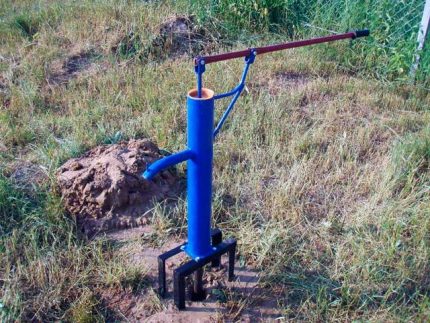
The classical method of immersing an Abyssinian well in the ground is carried out by banal driving - the simplest way, actively used among independent craftsmen. Clog until the bottom pipe with the tip does not open the aquifer.
Sometimes the column is partially buried by auger drilling, but renting a manual or mechanical drilling rig significantly increases the budget.
The Abyssinian well was invented and tested in practice during the war between colonial England and Ethiopia in 1867-68.The design proposed by the American engineer Norton tirelessly provided the British troops with water during their movement through the desert.
A device for extracting life-giving fluid from underground soil layers was quickly installed, dismantled and reused at the next halt.
Priorities such as mobility, cheapness and simplicity of construction were appreciated by the military, attracted travelers and researchers.

In Russia, a remarkable invention was introduced a year later at the end of the English campaign. A device for lifting water from shallow depths was described by K.I.
Of the five Abyssinian wells constructed in the Tsarskoye Selo region, two turned out to be quite suitable for obtaining fresh water. Three could not reach the aquifer due to limestone, which is close to the surface.
Successful Abyssinian wells were given per minute in a bucket. At first there was a muddy slurry, which after a half-hour pumping became quite transparent and clean.
Only the first aquifers from the earth's surface are opened with a needle-hole, therefore, the obtained water cannot be used for drinking purposes. It is suitable for watering, cleaning the territory and similar household needs.
If desired and an impressive production rate for water purification, a system can be installed coarse and fine filtersdelaying mechanical inclusion and chemical impurities.

Design specificity of the needle-well
Developed one and a half centuries ago, the Abyssinian drilling rig over the past years has not undergone fundamental structural changes. For some time, she was undeservedly forgotten. Although the pace and simplicity of the construction is noticeable, as well as the price of arrangement ahead of the widespread traditional wells.
Two main components are distinguished in the design of the Abyssinian well:
- Drillincluding the cutting tip and the trunk, which is built up in the process of deepening into the ground. The trunk also serves as a channel for lifting water from a depth. Therefore, it is assembled from pipe segments, and not from a steel circle or bar.
- Koper, consisting of a metal tripod and a weighty woman playing the role of a hammer. At the top of the tripod there are two blocks, with ropes stretched through them, to which the woman is attached.
When pulling the ropes, the woman rises to the top of the installation. When weakening, it rapidly falls on the podcubicum fixed on the trunk section that is rigidly fixed on the block to be drilled. The latter performs the function of an anvil, due to which the trunk is successively immersed in the ground.
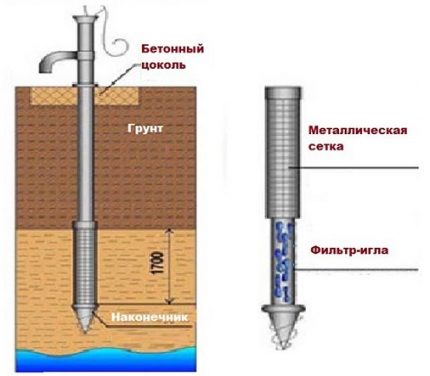
Podbabok is a kind of clamp, consisting of two symmetrical parts. The area of the podbabka in contact with the woman is slightly larger than the bottom area of the "hammer" falling on it.
After the clogged section of the trunk is almost completely immersed in the ground, the podcub is removed. The next one is screwed to the buried pipe section, on which the anvil clamp is once again fixed.
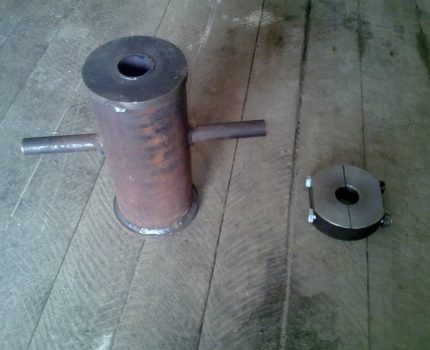
The steps to deepen the drill are repeated until the lower part of the do-it-yourself needle hole reaches the aquifer. The aquifer must not only be opened, but also walked at a minimum per meter.
According to the rules, the layer should be crossed at 2/3 of its capacity, but the actual size of the water carrier is probably unknown to an independent driller. It is difficult to judge them without hydrogeological surveys.
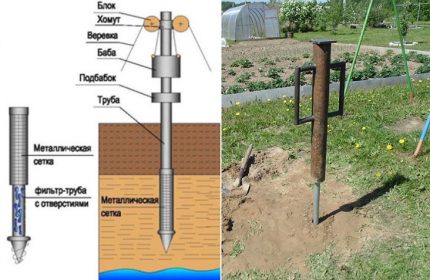
The appearance of water in the development must be periodically monitored. For professional drillers, for the purpose of measuring the level of water in a mine, there is a simple device that ideally determines the depth of the aquifer when it lies up to 15 m.
This is a hollow metal cylinder called a cracker. The device is like an inverted thin glass attached through a loop to a tape measure.
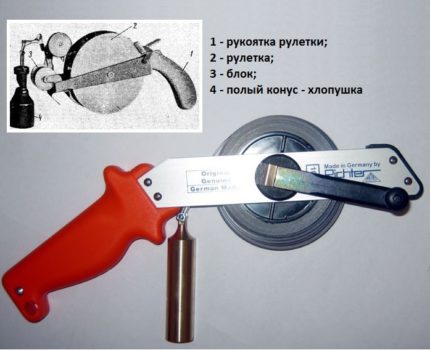
When the edge of the clapper comes in contact with the surface of the water, a clap is heard that tells about the appearance of the target in the well. You can make such a control device yourself by tying a large nut to the twine so that it can come in direct contact with the surface of the water.
Instead of a nut, it would be nice to find a not too lightweight plastic or metal cone, open on one or both sides.
There is another witty tool that serves as a control device. It is commonplace to monitor the appearance of water in the Abyssinian well by lowering an ordinary polymer pipe into the trunk. The contact with the groundwater mirror is signaled by a characteristic cotton.
Barrel manufacturing technology
There are no Abyssinian wells in industrial production. The manufacture of the installation is ordered in the workshop or made with your own hands.

In order to make a well a needle will need:
- Thick-walled pipes VGPin the marking of which is indicated “reinforced”. The optimal size of the outer diameter of the tube from 25 to 40 mm. It should be remembered that the thicker the trunk, the more difficult it is to hammer into the ground, and the thickness of the pipe will not affect the well’s flow rate.
- Steel tipmachined on a lathe. The length of the part is 10-12 cm, Ø 1-2 cm longer than the pipe Ø, so that the friction of the soil on the trunk does not slow down the clogging process. The tip can be conical or pyramidal, but not welded from wedge-shaped pipe scraps.
- Dense galun braided steel meshrequired for the additional filter device. It will prevent the ingress of small grains of sand and even clay suspension.
For the manufacture of the barrel, it is better to purchase a seamless pipe rolling, which, when driven, will definitely not crack. The pipe must be cut into sections of approximately 1.2 - 1.5 m. In drilling, they are called rods.
The indicated sizes are recommended on the basis of the greatest ease of use.The specific length of the segments in the designated interval depends on the estimated depth of the mine. It is desirable that one of them be 1 m for the final deepening into the aquifer.
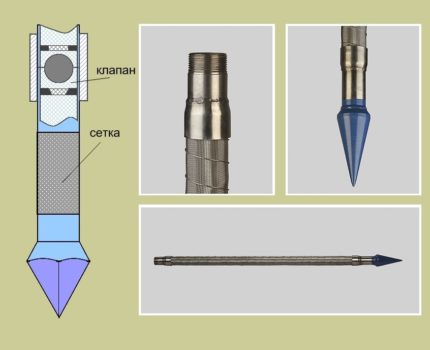
The extension of the barrel is performed as the shell deepens, and is carried out by successively wrapping sections of the VGP pipe.
To make connections along the edges of the segments, 7 turns of plumbing thread are cut and steel couplings are used. Connections are hermetically sealed; a sanitary tow is placed in the thread.
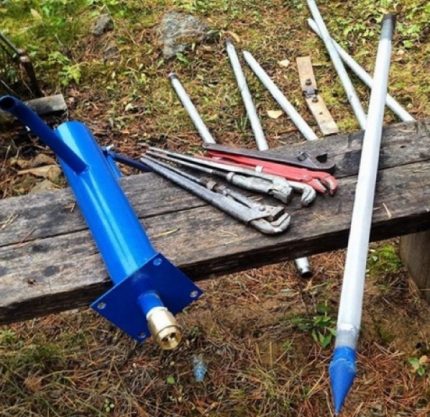
A tip is welded to the first segment of the future column and equipped with a primitive filter - this is the water intake part. In the starting section of the pipe, holes Ø 8 - 10 mm are drilled so that the elements of the indicated perforation are arranged in a checkerboard pattern.
Between conditional horizontal rows of holes should be about 5 cm: they should not be made closer, so as not to loosen the pipe.
Drill holes begin by stepping back from the bottom edge of about 15 cm with the same goal of maintaining strength indicators. At the junction of the first link of the column with the next rod is installed check valve pumping system.
Most often, this is a ball that allows water to flow only towards the pump.
Filter Element Improvement
The described filter will protect against ingress of gravel and small pebbles, but will not eliminate minor inclusions. Therefore, it needs modernization. To turn a perforated pipe section into a filter with a higher degree of protection, it needs to be modified.
Procedure:
- Coils of stainless wire are wound on top of the pipe. They are needed to increase the area of the filtering organ. The distance between the turns 3 - 5 mm.
- The resulting workpiece is tightly wrapped with a piece of stainless mesh, which is soldered to the walls of the pipe. Only tin solder is used, because the use of an alloy with lead will negatively affect the quality characteristics of water.
There is an opinion that for the greater importance, the modernized filter should be wrapped externally with a stainless steel wire rod. Let us doubt the reliability of such a strengthening. We believe that when immersed in the ground, the outer turns of a home-made filter will certainly detach, increase friction and significantly hamper clogging.
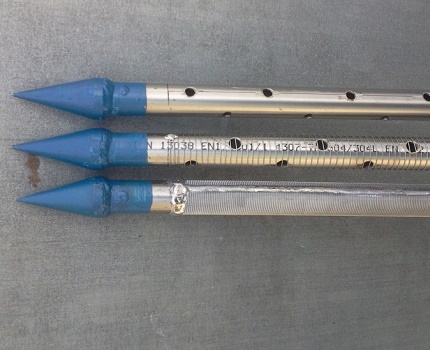
Refinement of the filter is a good thing, contributing not only to optimizing water quality, but also preventing silting of the needle well.
True, with the entire prostate of the device, strict adherence to the rules is required:
- A mesh screen made of brass or other non-ferrous metals is not suitable for a strainer. In alliance with steel, with a solid weld, they will form a galvanic pair, quickly and freely corroded by corrosion.
- The diameter of the perforated pipe together with the additional filter should not be equal to or exceed the maximum diameter of the tip. Otherwise, important filtering aids will separate from the pipe when driven into the ground.
- For the construction of the drill string and the first link, which is the water intake part of the trunk, fragile cast-iron pipes will not work.
You still should not save on couplings, buying handicrafts with poor-quality cutting. If the connections diverge during clogging, the needle will have to be dismantled and the well will go through again.
Conditions for the construction of the Abyssinian well
For the construction of the Abyssinian well, there is not enough ardent desire of the owner of the site, supported by knowledge of the design of the water intake installation. Before starting work, it is necessary to find out whether the geological conditions are suitable for the construction of a needle well.
Soils lying in the ground differ in physical and mechanical properties: in density, structure, hardness parameters, etc. Drillers have a classification according to the so-called "drillability" of rocks.
For the sinking of sandstone and sand, for example, a different type of tool and method of drilling are used. Rocky sandstone is drilled with a core pipe with a carbide crown, and water-bearing sands are lifted by a shock-rope method using a chipper.
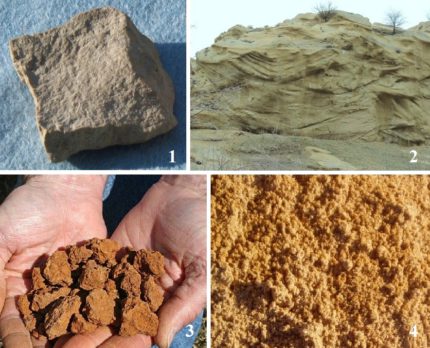
According to the set of physical and mechanical properties, together with the drillability of the rock, they are conditionally divided into:
- Solid or rocky. They are capable of cracking, crushing, and gradually collapse when drilling at high speed and pressure. Hard rocks are represented in the upper part of sediments by limestones, sandstones, marls, dolomites, etc.
- Plastic. They are easily or relatively easily amenable to cutting with a knife and a drilling tool, including the tip of an Abyssinian well. Plastic representatives include clay, loam, sandy loam with a high number of plasticity.
- Loose. They do not keep in shape, as consist of particles not connected to each other. When saturated with water, some dusty species can “swim”. The loose variety includes sands of all categories by size, gravel-pebble, sand-gravel and similar deposits.
At the disposal of home masters who want to tackle the construction of the Abyssinian well, there is no drilling tool for sinking all of the above types of soils. Independent drillers will be able to cross only plastic and loose categories. It is impossible to crush hard rock with the tip of the Abyssinian well.
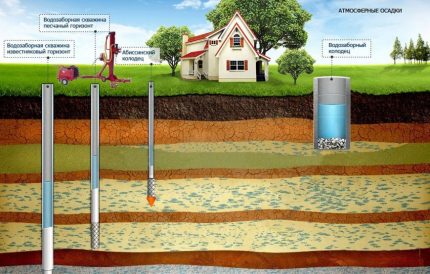
You should not try to break a large boulder: it is better to move a little and start working there again.Moreover, the dismantling of the water intake device is several times faster than the installation.
In addition to limitations on drillability, the height of a water mirror also affects the possibility of constructing a needle-well. The fact is that extracting it from the thin-barrel development can only be entrusted surface pumping equipment. Most brands of surface pumps are ready to lift water from a depth of not more than 8 m.
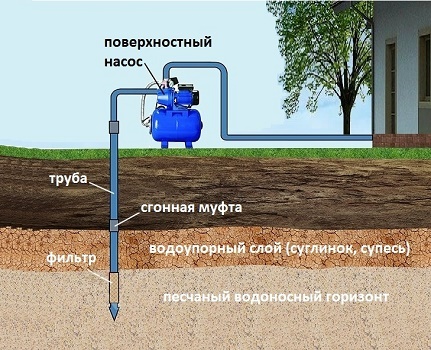
Even if the suction depth is indicated on the order of 10 m, we must not forget about the standard pressure loss in the barrel and that the pump usually also carries water along a horizontal section.
Every 10 m of horizontal movement takes 1 m from the suction depth. In addition, surface pumps are strongly recommended to be placed in enclosed spaces, and they are often removed from the point of water intake.
If, apart from the Abyssinian well, there is absolutely no way out, and the depth of the appearance of water in nearby wells is fixed at 12 - 15 m from the surface of the earth, then to raise the water you should stock up with an airlift or hand pump capable of pumping water from the indicated depth.
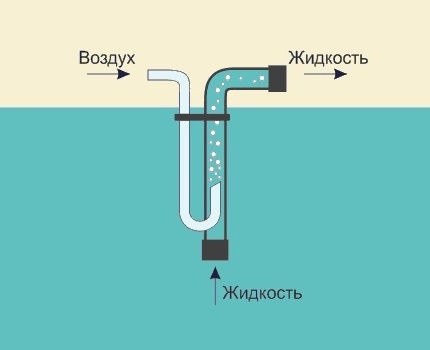
Useful information on how to find water for a well on a site and assess the location of aquifers is provided in this article.
An alternative way of adapting a water intake needle to an inappropriate groundwater level is to install a pit. Before driving the column into the ground, a pit is excavated with a depth of about a meter, the width of a shovel convenient for work in it. Rod driving then starts from the bottom of the pit. The pump in such situations is installed in the pit.

Hydrogeologist himself: soil assessment
No matter how simple the process of driving a needle well is, careful preparation for work is still necessary. It is not enough to stock up with rods and a starting link with a filter, to rent or make your own pile driver. We need information on the geological and hydrogeological situation in the area of the Abyssinian well.
Where and how to get them? Literally, we will gather information about the groundwater level in a neighboring well or in a well.
We can measure it ourselves with a cracker or ask the owner of the source about how deep he pumps water. At the same time, we find out what soil was lifted from the bottom when we were drilling or digging a hole.

In flat areas, rock strata occur almost horizontally with a slight bend or slight slope. The groundwater mirror is at approximately one absolute elevation. The difference in depth of the existing and planned well can be expressed only due to changes in relief.
Do not forget that the Abyssinian well reveals the top of the water or the aquifer following it, covered with clay or loam, but not with a rocky stop. Those. the water level in the mine will definitely be unstable - depending on the amount of precipitation.
During snowmelt and in rainy days, the groundwater mirror will be higher than during the dry weather season. The owner of the existing water intake point should find out what the maximum and minimum water level differences are, so that in the dry summer the Abyssinian well is not empty.
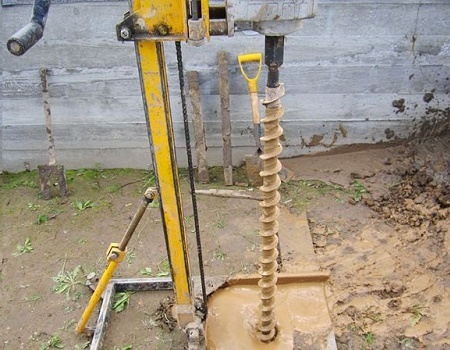
The issue of developed breeds is not at all idle. For example, in the Leningrad Region, water is extracted from large sands with a significant number of massive boulders.
Often, due to the inability to crush and remove a huge stone, drillers displace a water well. Similarly, it is worth doing if in the region of the construction of the Abyssinian well there are similar soils.
It makes no sense to drive with high occurrence of rock and semi-rock massifs. If in the neighboring area receive underground water, distributed in fractured dolomites, sandstones, limestones, then with the idea of constructing a needle-well, you will mercilessly part with.
Detailed information on geological surveys is described in the article - Where and when is it best to drill a well in the area: general rules + advice from experienced drillers
For those who decided to make an Abyssinian well with a pit, information is needed on the structure and condition of the soil layers that lie to the depth of the pit. If the incision is composed of sandy loam, loam or alternating layers, it is not necessary to strengthen the walls of the pit.
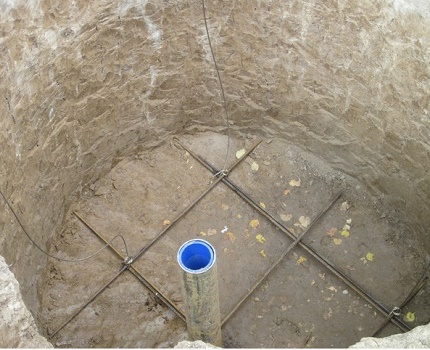
If the pit is dripping in the sand, the walls should be strengthened with board shields or concrete. Sand sides are unstable, can collapse and fall asleep at the water intake point along with pumping equipment.
Inquiries about the upper layers of the soil are also needed by those who plan to pass the upper part of the excavation with a screw. Auger drilling will significantly speed up the process, but may not bring the planned result. For work, they use a simple device - purchased or homemade drill.
With collapsing sand walls, installation is required casing pipedue to which the economic priorities of the Abyssinian well will be reduced.
Conclusions and useful video on the topic
Analysis of the pros and cons of the Abyssinian well against the background of a conventional well:
A video about deepening with a screw followed by a blockage of the Abyssinian well:
About the futility of finding water by the folk method using the framework:
Installation and operation of the Abyssinian well is the simplest and cheapest method of obtaining water from the upper aquifers. For the construction of water intake development, no equipment is required, all stages of the work can easily be done with your own hands.
Invested efforts and insignificant funds will quickly pay off, the Abyssinian well will serve no less than traditional sources of water. It is important to catch fire and realize the idea, armed with the information we presented.
Do you have practical skills in arranging a needle-well on a site? Please share your knowledge or ask questions on the topic in the comments below.

 How to make water supply in the country from the well with your own hands: we carry water into the house
How to make water supply in the country from the well with your own hands: we carry water into the house 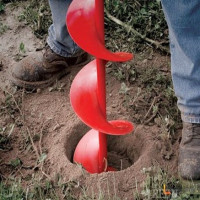 How to drill a well with your own hands: ways to budget independent drilling
How to drill a well with your own hands: ways to budget independent drilling 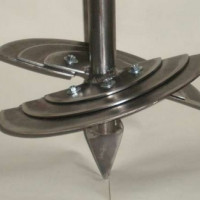 How to make a drill for a well with your own hands: the best homemade schemes
How to make a drill for a well with your own hands: the best homemade schemes  Do-it-yourself well without equipment: how to independently arrange a water source
Do-it-yourself well without equipment: how to independently arrange a water source 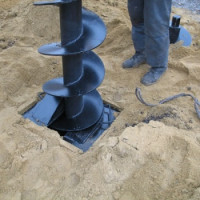 Where and when is it best to drill a well in the area: general rules + advice from experienced drillers
Where and when is it best to drill a well in the area: general rules + advice from experienced drillers  Do-it-yourself deepening of the well: a review of the best methods to get to the aquifer
Do-it-yourself deepening of the well: a review of the best methods to get to the aquifer  How much does it cost to connect gas to a private house: the price of organizing gas supply
How much does it cost to connect gas to a private house: the price of organizing gas supply  The best washing machines with dryer: model rating and customer tips
The best washing machines with dryer: model rating and customer tips  What is the color temperature of light and the nuances of choosing the temperature of the lamps to suit your needs
What is the color temperature of light and the nuances of choosing the temperature of the lamps to suit your needs  Replacement of a geyser in an apartment: replacement paperwork + basic norms and requirements
Replacement of a geyser in an apartment: replacement paperwork + basic norms and requirements
Yes, that's right, but when reading the article I had a logical question. So what, will you have to make two wells on the site? One for household needs, the second as a source of drinking water. But let me, why? Of course, you can mount a cleaning system, but it will have to be serviced and periodically changed. In my opinion, it is better to drill one artesian well, and use water for everything.I don’t know how in other regions, but in Khabarovsk, well water of disgusting quality.
There are pros and cons to such a well. The price is two or even four times less than if you make a familiar well with concrete rings. If done normally, then the water rises from the depths, so it is clean, the top water does not enter. The water is usually soft, iron-free, can be used in food without special purification. But there is a chance to slip through the layer and have to raise the well. And not in every section this method will pass: the aquifer can lie deeper than 15 m.